Ying Cui
Fast MLE and MAPE-Based Device Activity Detection for Grant-Free Access via PSCA and PSCA-Net
Mar 19, 2025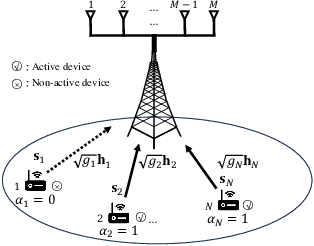

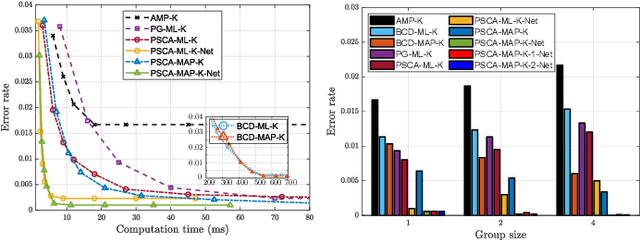

Abstract:Fast and accurate device activity detection is the critical challenge in grant-free access for supporting massive machine-type communications (mMTC) and ultra-reliable low-latency communications (URLLC) in 5G and beyond. The state-of-the-art methods have unsatisfactory error rates or computation times. To address these outstanding issues, we propose new maximum likelihood estimation (MLE) and maximum a posterior estimation (MAPE) based device activity detection methods for known and unknown pathloss that achieve superior error rate and computation time tradeoffs using optimization and deep learning techniques. Specifically, we investigate four non-convex optimization problems for MLE and MAPE in the two pathloss cases, with one MAPE problem being formulated for the first time. For each non-convex problem, we develop an innovative parallel iterative algorithm using the parallel successive convex approximation (PSCA) method. Each PSCA-based algorithm allows parallel computations, uses up to the objective function's second-order information, converges to the problem's stationary points, and has a low per-iteration computational complexity compared to the state-of-the-art algorithms. Then, for each PSCA-based iterative algorithm, we present a deep unrolling neural network implementation, called PSCA-Net, to further reduce the computation time. Each PSCA-Net elegantly marries the underlying PSCA-based algorithm's parallel computation mechanism with the parallelizable neural network architecture and effectively optimizes its step sizes based on vast data samples to speed up the convergence. Numerical results demonstrate that the proposed methods can significantly reduce the error rate and computation time compared to the state-of-the-art methods, revealing their significant values for grant-free access.
Distill Any Depth: Distillation Creates a Stronger Monocular Depth Estimator
Feb 26, 2025Abstract:Monocular depth estimation (MDE) aims to predict scene depth from a single RGB image and plays a crucial role in 3D scene understanding. Recent advances in zero-shot MDE leverage normalized depth representations and distillation-based learning to improve generalization across diverse scenes. However, current depth normalization methods for distillation, relying on global normalization, can amplify noisy pseudo-labels, reducing distillation effectiveness. In this paper, we systematically analyze the impact of different depth normalization strategies on pseudo-label distillation. Based on our findings, we propose Cross-Context Distillation, which integrates global and local depth cues to enhance pseudo-label quality. Additionally, we introduce a multi-teacher distillation framework that leverages complementary strengths of different depth estimation models, leading to more robust and accurate depth predictions. Extensive experiments on benchmark datasets demonstrate that our approach significantly outperforms state-of-the-art methods, both quantitatively and qualitatively.
DiffCalib: Reformulating Monocular Camera Calibration as Diffusion-Based Dense Incident Map Generation
May 24, 2024Abstract:Monocular camera calibration is a key precondition for numerous 3D vision applications. Despite considerable advancements, existing methods often hinge on specific assumptions and struggle to generalize across varied real-world scenarios, and the performance is limited by insufficient training data. Recently, diffusion models trained on expansive datasets have been confirmed to maintain the capability to generate diverse, high-quality images. This success suggests a strong potential of the models to effectively understand varied visual information. In this work, we leverage the comprehensive visual knowledge embedded in pre-trained diffusion models to enable more robust and accurate monocular camera intrinsic estimation. Specifically, we reformulate the problem of estimating the four degrees of freedom (4-DoF) of camera intrinsic parameters as a dense incident map generation task. The map details the angle of incidence for each pixel in the RGB image, and its format aligns well with the paradigm of diffusion models. The camera intrinsic then can be derived from the incident map with a simple non-learning RANSAC algorithm during inference. Moreover, to further enhance the performance, we jointly estimate a depth map to provide extra geometric information for the incident map estimation. Extensive experiments on multiple testing datasets demonstrate that our model achieves state-of-the-art performance, gaining up to a 40% reduction in prediction errors. Besides, the experiments also show that the precise camera intrinsic and depth maps estimated by our pipeline can greatly benefit practical applications such as 3D reconstruction from a single in-the-wild image.
Fast Computation of Superquantile-Constrained Optimization Through Implicit Scenario Reduction
May 13, 2024Abstract:Superquantiles have recently gained significant interest as a risk-aware metric for addressing fairness and distribution shifts in statistical learning and decision making problems. This paper introduces a fast, scalable and robust second-order computational framework to solve large-scale optimization problems with superquantile-based constraints. Unlike empirical risk minimization, superquantile-based optimization requires ranking random functions evaluated across all scenarios to compute the tail conditional expectation. While this tail-based feature might seem computationally unfriendly, it provides an advantageous setting for a semismooth-Newton-based augmented Lagrangian method. The superquantile operator effectively reduces the dimensions of the Newton systems since the tail expectation involves considerably fewer scenarios. Notably, the extra cost of obtaining relevant second-order information and performing matrix inversions is often comparable to, and sometimes even less than, the effort required for gradient computation. Our developed solver is particularly effective when the number of scenarios substantially exceeds the number of decision variables. In synthetic problems with linear and convex diagonal quadratic objectives, numerical experiments demonstrate that our method outperforms existing approaches by a large margin: It achieves speeds more than 750 times faster for linear and quadratic objectives than the alternating direction method of multipliers as implemented by OSQP for computing low-accuracy solutions. Additionally, it is up to 25 times faster for linear objectives and 70 times faster for quadratic objectives than the commercial solver Gurobi, and 20 times faster for linear objectives and 30 times faster for quadratic objectives than the Portfolio Safeguard optimization suite for high-accuracy solution computations.
Evaluation of ChatGPT-Generated Medical Responses: A Systematic Review and Meta-Analysis
Oct 12, 2023Abstract:Large language models such as ChatGPT are increasingly explored in medical domains. However, the absence of standard guidelines for performance evaluation has led to methodological inconsistencies. This study aims to summarize the available evidence on evaluating ChatGPT's performance in medicine and provide direction for future research. We searched ten medical literature databases on June 15, 2023, using the keyword "ChatGPT". A total of 3520 articles were identified, of which 60 were reviewed and summarized in this paper and 17 were included in the meta-analysis. The analysis showed that ChatGPT displayed an overall integrated accuracy of 56% (95% CI: 51%-60%, I2 = 87%) in addressing medical queries. However, the studies varied in question resource, question-asking process, and evaluation metrics. Moreover, many studies failed to report methodological details, including the version of ChatGPT and whether each question was used independently or repeatedly. Our findings revealed that although ChatGPT demonstrated considerable potential for application in healthcare, the heterogeneity of the studies and insufficient reporting may affect the reliability of these results. Further well-designed studies with comprehensive and transparent reporting are needed to evaluate ChatGPT's performance in medicine.
GQFedWAvg: Optimization-Based Quantized Federated Learning in General Edge Computing Systems
Jun 13, 2023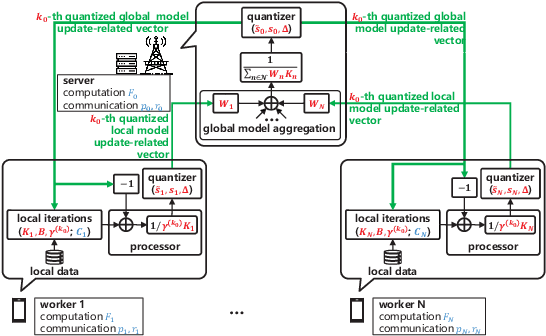

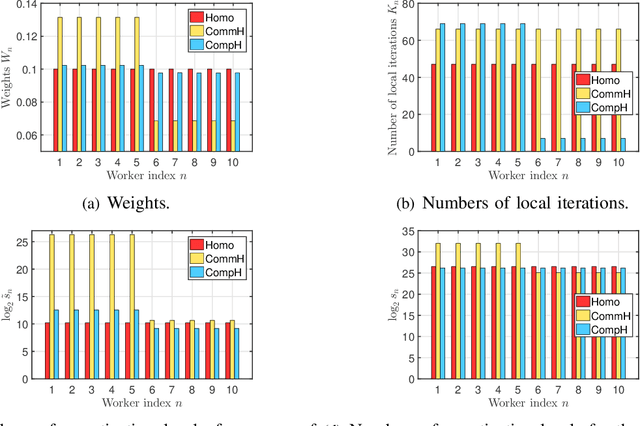

Abstract:The optimal implementation of federated learning (FL) in practical edge computing systems has been an outstanding problem. In this paper, we propose an optimization-based quantized FL algorithm, which can appropriately fit a general edge computing system with uniform or nonuniform computing and communication resources at the workers. Specifically, we first present a new random quantization scheme and analyze its properties. Then, we propose a general quantized FL algorithm, namely GQFedWAvg. Specifically, GQFedWAvg applies the proposed quantization scheme to quantize wisely chosen model update-related vectors and adopts a generalized mini-batch stochastic gradient descent (SGD) method with the weighted average local model updates in global model aggregation. Besides, GQFedWAvg has several adjustable algorithm parameters to flexibly adapt to the computing and communication resources at the server and workers. We also analyze the convergence of GQFedWAvg. Next, we optimize the algorithm parameters of GQFedWAvg to minimize the convergence error under the time and energy constraints. We successfully tackle the challenging non-convex problem using general inner approximation (GIA) and multiple delicate tricks. Finally, we interpret GQFedWAvg's function principle and show its considerable gains over existing FL algorithms using numerical results.
MLE-based Device Activity Detection under Rician Fading for Massive Grant-free Access with Perfect and Imperfect Synchronization
Jun 11, 2023Abstract:Most existing studies on massive grant-free access, proposed to support massive machine-type communications (mMTC) for the Internet of things (IoT), assume Rayleigh fading and perfect synchronization for simplicity. However, in practice, line-of-sight (LoS) components generally exist, and time and frequency synchronization are usually imperfect. This paper systematically investigates maximum likelihood estimation (MLE)-based device activity detection under Rician fading for massive grant-free access with perfect and imperfect synchronization. Specifically, we formulate device activity detection in the synchronous case and joint device activity and offset detection in three asynchronous cases (i.e., time, frequency, and time and frequency asynchronous cases) as MLE problems. In the synchronous case, we propose an iterative algorithm to obtain a stationary point of the MLE problem. In each asynchronous case, we propose two iterative algorithms with identical detection performance but different computational complexities. In particular, one is computationally efficient for small ranges of offsets, whereas the other one, relying on fast Fourier transform (FFT) and inverse FFT, is computationally efficient for large ranges of offsets. The proposed algorithms generalize the existing MLE-based methods for Rayleigh fading and perfect synchronization. Numerical results show the notable gains of the proposed algorithms over existing methods in detection accuracy and computation time.
Trustworthy Multi-phase Liver Tumor Segmentation via Evidence-based Uncertainty
May 09, 2023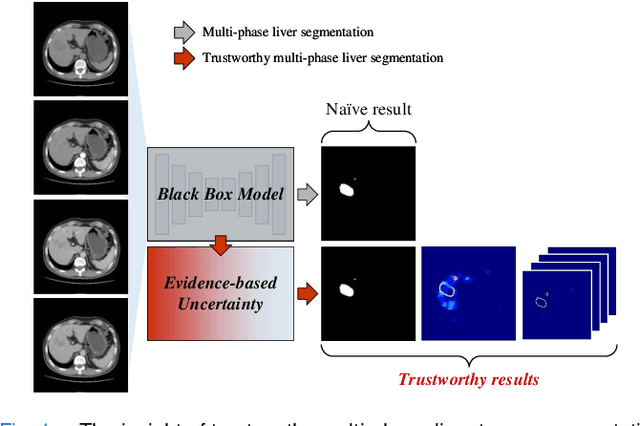
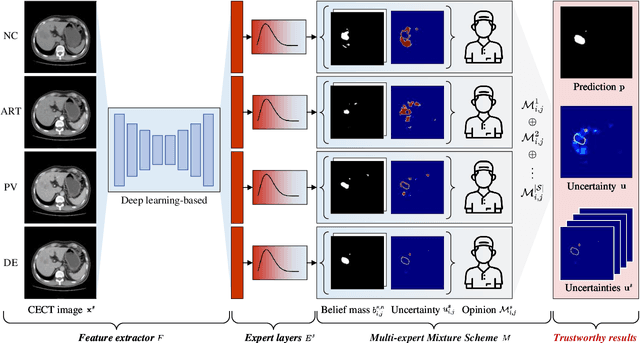
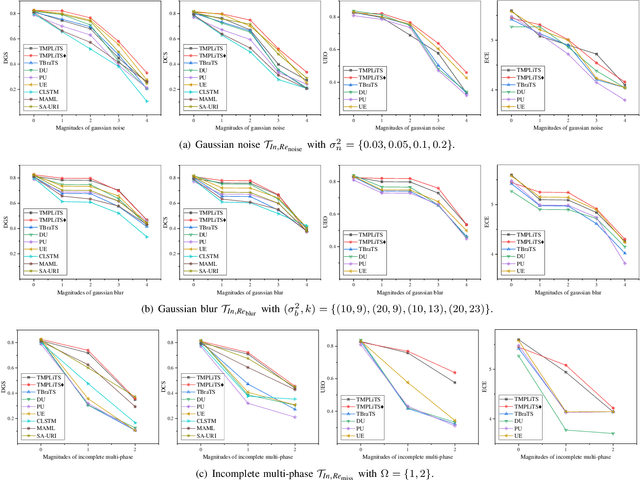

Abstract:Multi-phase liver contrast-enhanced computed tomography (CECT) images convey the complementary multi-phase information for liver tumor segmentation (LiTS), which are crucial to assist the diagnosis of liver cancer clinically. However, the performances of existing multi-phase liver tumor segmentation (MPLiTS)-based methods suffer from redundancy and weak interpretability, % of the fused result, resulting in the implicit unreliability of clinical applications. In this paper, we propose a novel trustworthy multi-phase liver tumor segmentation (TMPLiTS), which is a unified framework jointly conducting segmentation and uncertainty estimation. The trustworthy results could assist the clinicians to make a reliable diagnosis. Specifically, Dempster-Shafer Evidence Theory (DST) is introduced to parameterize the segmentation and uncertainty as evidence following Dirichlet distribution. The reliability of segmentation results among multi-phase CECT images is quantified explicitly. Meanwhile, a multi-expert mixture scheme (MEMS) is proposed to fuse the multi-phase evidences, which can guarantee the effect of fusion procedure based on theoretical analysis. Experimental results demonstrate the superiority of TMPLiTS compared with the state-of-the-art methods. Meanwhile, the robustness of TMPLiTS is verified, where the reliable performance can be guaranteed against the perturbations.
Joint Device Activity Detection, Channel Estimation and Signal Detection for Massive Grant-free Access via BiGAMP
Apr 03, 2023
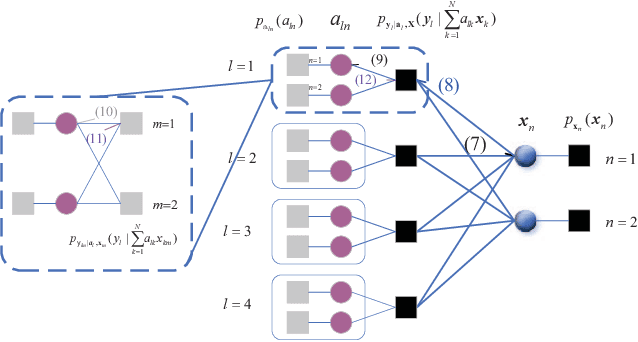


Abstract:Massive access has been challenging for the fifth generation (5G) and beyond since the abundance of devices causes communication overload to skyrocket. In an uplink massive access scenario, device traffic is sporadic in any given coherence time. Thus, channels across the antennas of each device exhibit correlation, which can be characterized by the row sparse channel matrix structure. In this work, we develop a bilinear generalized approximate message passing (BiGAMP) algorithm based on the row sparse channel matrix structure. This algorithm can jointly detect device activities, estimate channels, and detect signals in massive multiple-input multiple-output (MIMO) systems by alternating updates between channel matrices and signal matrices. The signal observation provides additional information for performance improvement compared to the existing algorithms. We further analyze state evolution (SE) to measure the performance of the proposed algorithm and characterize the convergence condition for SE. Moreover, we perform theoretical analysis on the error probability of device activity detection, the mean square error of channel estimation, and the symbol error rate of signal detection. The numerical results demonstrate the superiority of the proposed algorithm over the state-of-the-art methods in DADCE-SD, and the numerical results are relatively close to the theoretical analysis results.
Optimization and Optimizers for Adversarial Robustness
Mar 23, 2023



Abstract:Empirical robustness evaluation (RE) of deep learning models against adversarial perturbations entails solving nontrivial constrained optimization problems. Existing numerical algorithms that are commonly used to solve them in practice predominantly rely on projected gradient, and mostly handle perturbations modeled by the $\ell_1$, $\ell_2$ and $\ell_\infty$ distances. In this paper, we introduce a novel algorithmic framework that blends a general-purpose constrained-optimization solver PyGRANSO with Constraint Folding (PWCF), which can add more reliability and generality to the state-of-the-art RE packages, e.g., AutoAttack. Regarding reliability, PWCF provides solutions with stationarity measures and feasibility tests to assess the solution quality. For generality, PWCF can handle perturbation models that are typically inaccessible to the existing projected gradient methods; the main requirement is the distance metric to be almost everywhere differentiable. Taking advantage of PWCF and other existing numerical algorithms, we further explore the distinct patterns in the solutions found for solving these optimization problems using various combinations of losses, perturbation models, and optimization algorithms. We then discuss the implications of these patterns on the current robustness evaluation and adversarial training.
 Add to Chrome
Add to Chrome Add to Firefox
Add to Firefox Add to Edge
Add to Edge